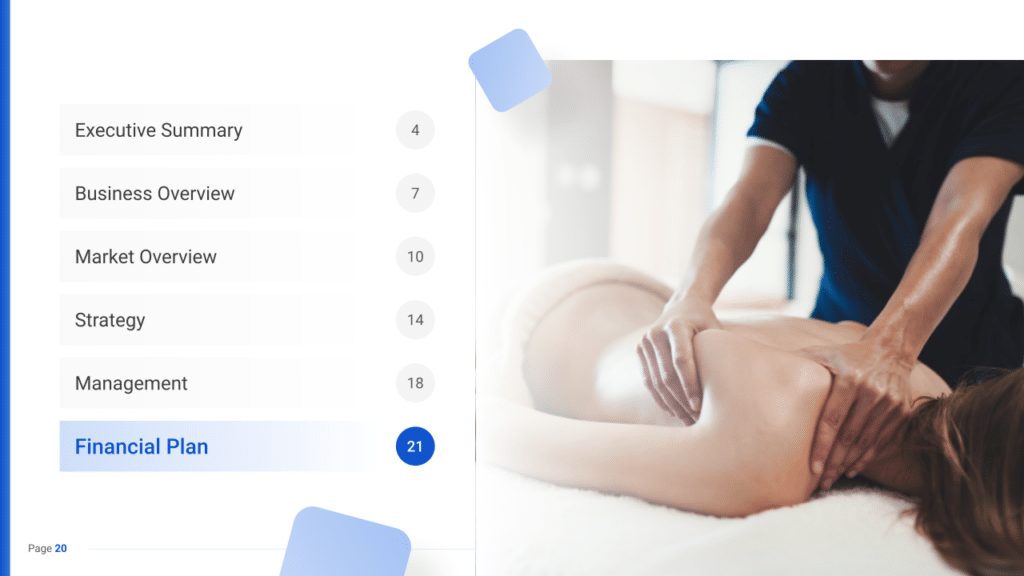Massage Therapy Business Plan Template & PDF Example
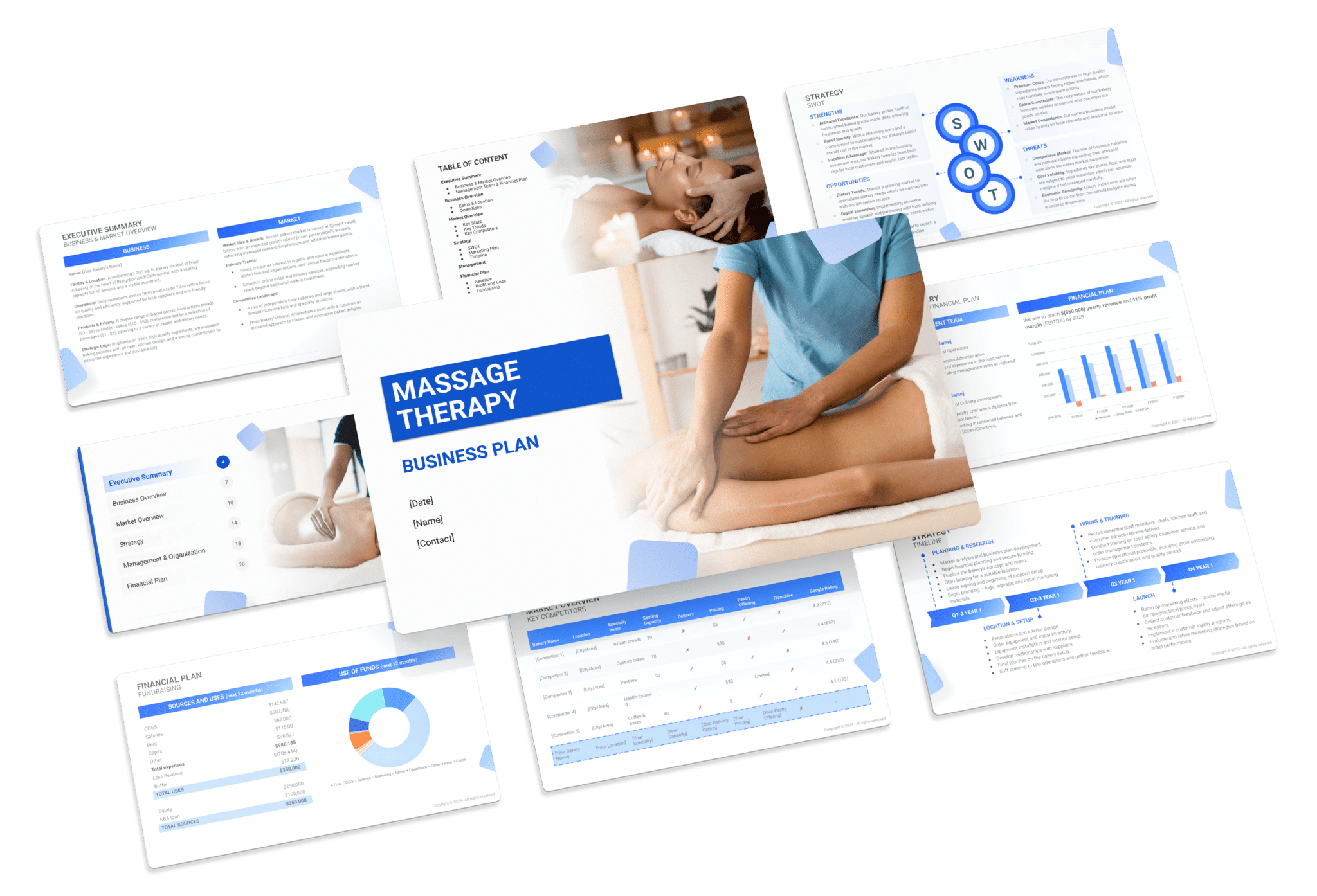
Creating a comprehensive business plan is crucial for launching and running a successful massage therapy business. This plan serves as your roadmap, detailing your vision, operational strategies, and financial plan. It helps establish your massage therapy business’s identity, navigate the competitive market, and secure funding for growth.
This article not only breaks down the critical components of a massage therapy business plan, but also provides an example of a business plan to help you craft your own.
Whether you’re an experienced entrepreneur or new to the beauty industry, this guide, complete with a business plan example, lays the groundwork for turning your massage therapy concept into reality. Let’s dive in!
The Plan
Our massage therapy business plan is crafted to include all essential elements required for a well-rounded strategic blueprint. It details the practice’s service methodologies, marketing approaches, market environment, competitive analysis, management structure, and financial projections.
- Executive Summary: Offers an overview of your massage therapy clinic’s concept, market analysis, management, and financial strategy.
- Business Overview: Provides detailed information on your clinic and its operational model:
- Clinic & Location: Describes the facility’s ambiance, layout, and strategic location for accessibility and client convenience.
- Treatments & Prices: Lists the range of massage therapy treatments offered, such as Swedish, Deep Tissue, Sports, and Prenatal massages, with a clear pricing structure.
- Market Overview: Examines the massage therapy industry landscape, identifying competitors and how your clinic stands out:
- Key Stats: Shares industry size, growth trends, and relevant statistics for the massage therapy market.
- Key Trends: Highlights recent trends in massage therapy, such as the growing emphasis on holistic health and the integration of diverse massage techniques.
- Key Competitors: Analyzes main competitors in your area and differentiates your clinic in terms of service quality, range of treatments, and client care.
- Strategy: Outlines how the massage therapy clinic intends to achieve growth and attract clients:
- SWOT: Strengths, weaknesses, opportunities, and threats analysis tailored to your massage therapy clinic.
- Marketing Plan: Specifies marketing strategies to promote your services, including digital marketing, local community engagement, and partnerships with health and wellness centers.
- Timeline: Key milestones and objectives from the initial setup to the first year of operations, detailing steps such as business planning, legal setup, facility preparation, and launch marketing activities.
- Management: Information on the management team, highlighting their expertise in massage therapy, healthcare management, and client relations.
- Financial Plan: Projects the 5-year financial performance of the massage therapy clinic, including revenue targets, profit and loss statements, fundraising needs, cash flow projections, and balance sheet forecasts, aiming for specific revenue and profit margins by a set year.
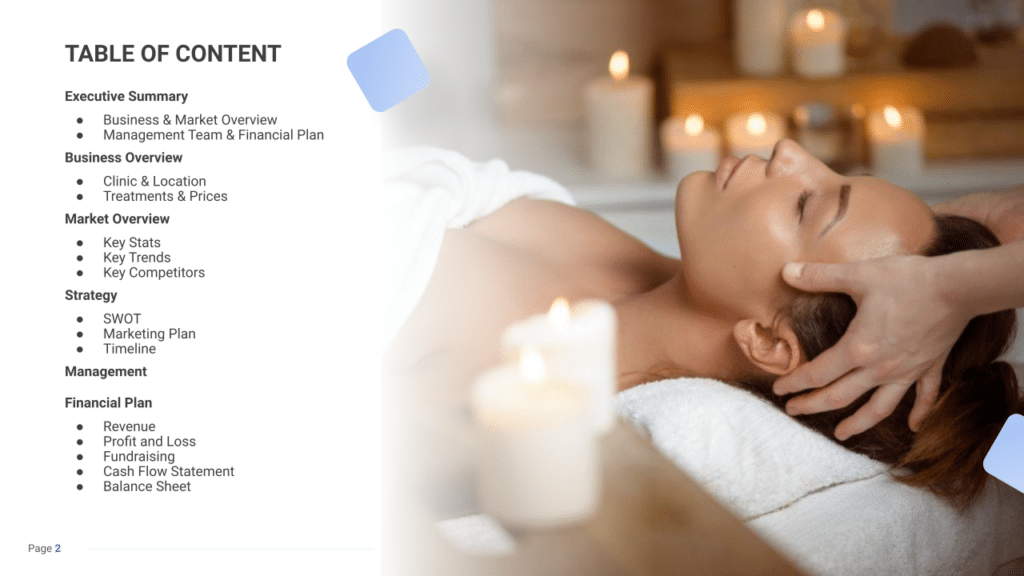
Executive Summary
The Executive Summary introduces your massage therapy business plan, offering a concise overview of your clinic and its services. It should detail your market positioning, the range of massage therapy services you offer, including specialized techniques such as Swedish, deep tissue, or sports massages, its location, size, and an outline of day-to-day operations.
This section should also explore how your massage therapy clinic will integrate into the local market, including the number of direct competitors within the area, identifying who they are, along with your clinic’s unique selling points that differentiate it from these competitors. This could include specialized services, unique treatment approaches, or superior customer service.
Furthermore, you should include information about the management and co-founding team, detailing their roles, qualifications, and contributions to the clinic’s success. Additionally, a summary of your financial projections, including revenue and profits over the next five years, should be presented here to provide a clear picture of your clinic’s financial plan.
Massage Therapy Business Plan Executive Summary Example
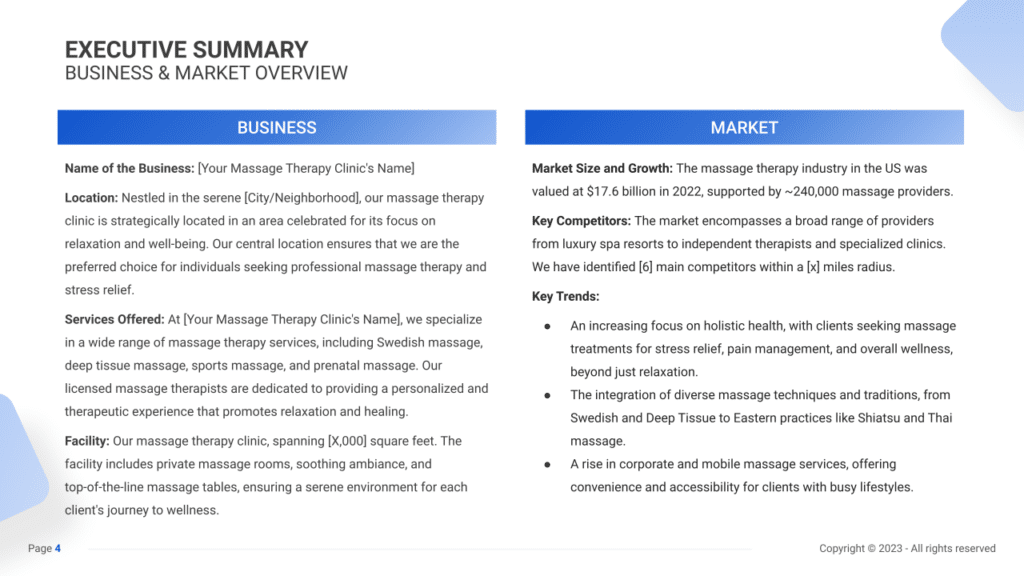

Business Overview
A concise overview is pivotal, introducing essential details like the clinic’s name, location, and a snapshot of its core services.
These details set the stage for your massage therapy clinic, framing its unique characteristics. A unique selling proposition (USP) distinguishes your clinic. Whether it’s expertise in therapeutic techniques, a focus on holistic wellness, or a commitment to personalized care, highlight this USP in your executive summary to showcase your clinic’s distinctive value proposition.
Example:
“Serenity Wellness Spa & Massage Clinic,” situated in the serene heart of Tranquil Town, occupies a spacious 2,500 square feet area on Blissful Street. We specialize in a diverse array of massage therapy services, including Swedish massage, deep tissue massage, sports massage, and prenatal massage. Our USP lies in blending therapeutic massage techniques with personalized care, fostering relaxation and healing for each client.
Market Overview
Understanding market dynamics and your position within it is crucial. This section should underscore the potential of the local massage therapy market, supported by relevant data such as market value and growth rates. Discussing trends, such as the growing demand for alternative and complementary therapies or the focus on stress relief and wellness, illuminates your clinic’s positioning within the evolving landscape.
Additionally, it highlights the competitive landscape. Identify key competitors and elucidate how your clinic stands out amidst competition. Whether through specialized techniques, a serene ambiance, or a focus on holistic healing, emphasize how your clinic differentiates itself.
Example:
In the local massage therapy market of Tranquil Town, valued at $2.5 million annually with a 10% growth rate, Serenity Wellness Spa & Massage Clinic leads with a focus on therapeutic wellness and a comprehensive range of services. Amidst competition, our commitment to personalized client experiences positions us as the preferred choice for clients seeking relaxation and healing.
Management Team
Highlight the expertise and background of your management team, showcasing their capabilities in driving clinic success.
This could include your clinic director’s extensive experience in massage therapy or your operations lead’s proficiency in healthcare management. Demonstrating the team’s competency builds credibility and assures potential investors and partners of your clinic’s potential for success.
Example:
At Serenity Wellness Spa & Massage Clinic, Emma Johnson, with over two decades in massage therapy and holistic health practices, leads operations. Supported by a team of licensed massage therapists and a healthcare management director experienced in complementary therapies, the clinic maintains a focus on delivering holistic wellness and healing to every client.
Financial Plan
Provide an overview of your financial goals and projections, offering insights into revenue targets, profit margins, and anticipated growth trajectories.
Example:
Serenity Wellness Spa & Massage Clinic aims for a projected revenue of $1.2 million annually, targeting a 20% EBITDA profit margin. Investment in top-quality massage equipment and a strong focus on personalized client care, complemented by wellness program offerings and community engagement, drives anticipated growth and profitability within the local market.
Business Overview
For a Massage Therapy clinic, the Business Overview section can be effectively divided into 2 main components:
Clinic & Location
Briefly describe the clinic’s physical setting, emphasizing its ambiance, tranquility, and the overall therapeutic environment that welcomes clients. Mention the clinic’s location, highlighting its accessibility and the convenience it offers to clients, such as proximity to wellness centers or ease of parking. Explain why this location is advantageous in attracting your target clientele, focusing on aspects like a serene setting, privacy, or a health-oriented community.
Treatments & Prices
Detail the range of massage therapy services offered, from general wellness and relaxation massages like Swedish or aromatherapy to specialized treatments such as deep tissue, sports massage, or reflexology. Outline your pricing strategy, ensuring it reflects the expertise of your therapists, the quality of services provided, and matches the market you’re targeting. Highlight any packages, membership deals, or loyalty programs that provide added value to your clients, encouraging repeat business and customer loyalty. This could also include introductory offers for new clients, gift cards, or bundled packages for multiple sessions.
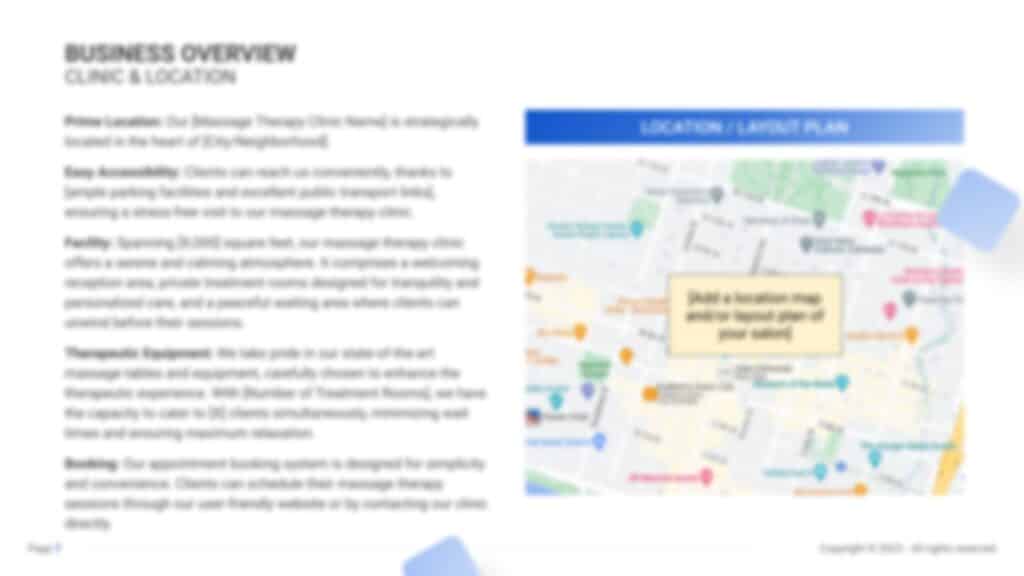
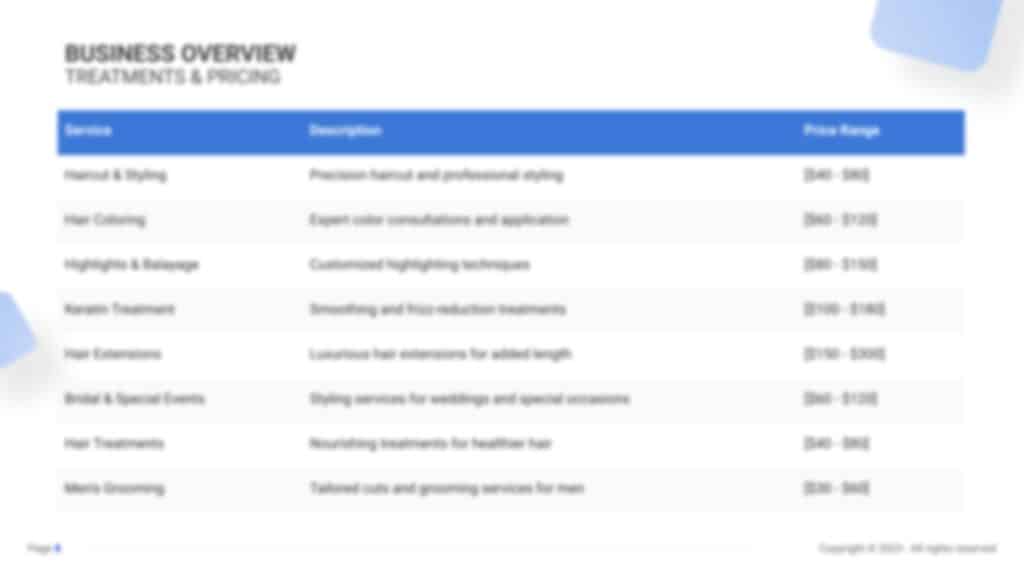
Market Overview

Industry size & growth
In the Market Overview of your massage therapy clinic business plan, start by examining the size of the massage therapy industry and its growth potential. This analysis is crucial for understanding the market’s scope and identifying expansion opportunities.
Highlight statistics and forecasts that demonstrate the increasing demand for massage therapy services, influenced by growing awareness of health, wellness, and the benefits of alternative and complementary medicine.
Key market trends
Proceed to discuss recent market trends, such as the increasing consumer interest in holistic health practices, personalized wellness plans, and the integration of technology in wellness services.
For example, highlight the demand for specialized massage therapies that cater to specific health issues, stress relief, or sports recovery, alongside the rising popularity of clinics that offer a comprehensive wellness experience, including meditation, yoga, and nutrition counseling.
Competitive Landscape
A competitive analysis is not just a tool for gauging the position of your massage therapy service in the market and its key competitors; it’s also a fundamental component of your business plan. This analysis helps in identifying your massage therapy service’s unique selling points, essential for differentiating your business in a competitive market.
In addition, competitive analysis is integral in laying a solid foundation for your business plan. By examining various operational aspects of your competitors, you gain valuable information that ensures your business plan is robust, informed, and tailored to succeed in the current market environment.
Identifying Your Massage Therapy Service Competitors
In this stage, it’s essential to conduct thorough research to identify both direct and indirect competitors in the massage therapy industry. Direct competitors typically include other massage therapy clinics, wellness centers, or spas within your local area. However, don’t overlook indirect competitors, which could consist of chiropractors, yoga studios, or even mobile massage services.
Utilize a mix of online tools and local directories to map out competitors locations and gather vital information. Review platforms like Yelp, Google Reviews, or specialized massage therapy websites often provide invaluable insights through client feedback and ratings. Analyzing these reviews can offer crucial information about what clients appreciate or critique about competitors’ services, such as exceptional customer service at “Zen Tranquility Spa” or specialized therapies at “Healing Hands Wellness Center.”
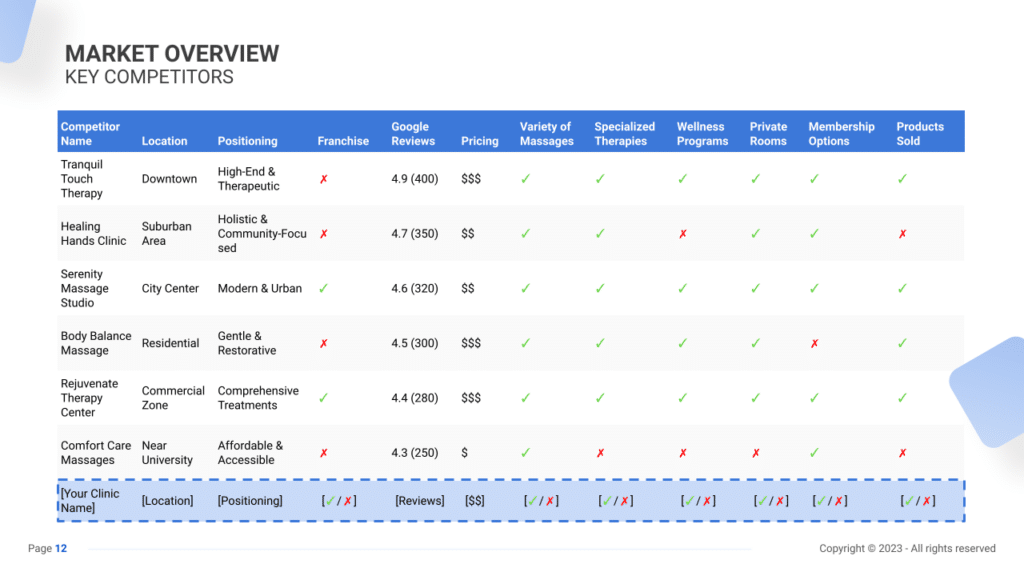
Massage Therapy Service Competitors’ Strategies
Analyzing competitors involves examining various aspects of their business strategies:
- Range of Services: Take note of the different massage modalities and wellness treatments your competitors offer. For instance, “Harmony Health Clinic” might focus on prenatal massages, while “Body Balance Center” specializes in deep tissue and rehabilitation therapies.
- Techniques and Specializations: Consider the unique techniques and specializations your competitors highlight. For example, “Natural Wellness Spa” may emphasize organic products and holistic treatments, differentiating themselves from those that offer more traditional massage therapies.
- Pricing Models: Compare and contrast the pricing structures of your massage therapy service with those of competitors. Are your rates aligned with those of “Ease & Relax Clinic,” which positions itself as an affordable option, or do you cater to a high-end market similar to “Tranquil Retreat Spa”?
- Marketing Channels: Analyze the marketing strategies employed by competitors. Determine if they leverage social media, cultivate partnerships with local businesses, or focus on referral programs to attract and retain clients.
- Client Experience: Assess the overall ambiance and client experience at competitors’ establishments. For instance, “Blissful Moments Spa” might prioritize a luxurious and serene environment, while “Vitality Haven” might emphasize a more health-oriented, clinical ambiance.
- Operational Efficiency: Look for technological advancements or innovative practices. For instance, “TechCare Massage Clinic” might utilize sophisticated booking apps and online portals for client records or incorporate wellness-tracking devices for personalized treatments.
What’s Your Massage Therapy Service’s Value Proposition?
Define your massage therapy service’s unique value proposition. It could be a specialization in a specific massage technique, a focus on personalized client care, or a niche offering such as on-site corporate massages.
Identify gaps in the market by analyzing customer preferences and emerging trends. For instance, a rising interest in holistic wellness might signal an opportunity to introduce holistic healing packages if competitors are yet to tap into this segment.
Consider your location and clientele preferences. A clinic in a business district might cater to stress relief for professionals, while a center in a wellness-oriented neighborhood might emphasize holistic health and mindfulness.
Strategy
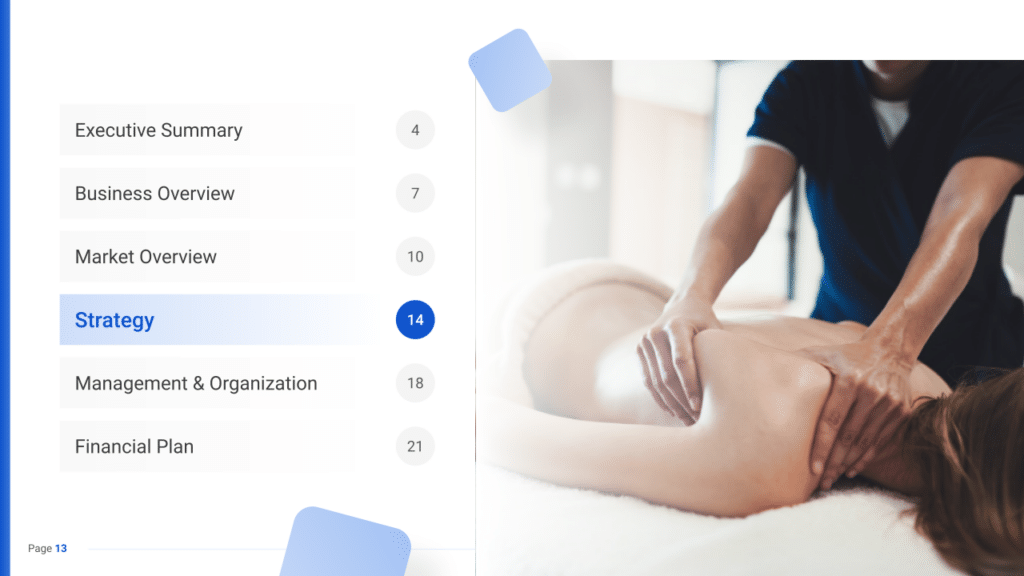
SWOT
First, conduct a SWOT analysis for the massage therapy clinic, highlighting Strengths (such as certified and experienced therapists, and a diverse range of massage modalities), Weaknesses (including potential high overhead costs or stiff competition in the area), Opportunities (for example, a growing public interest in wellness and preventive health care), and Threats (such as changes in health care regulations or economic downturns that may impact discretionary spending on wellness services).
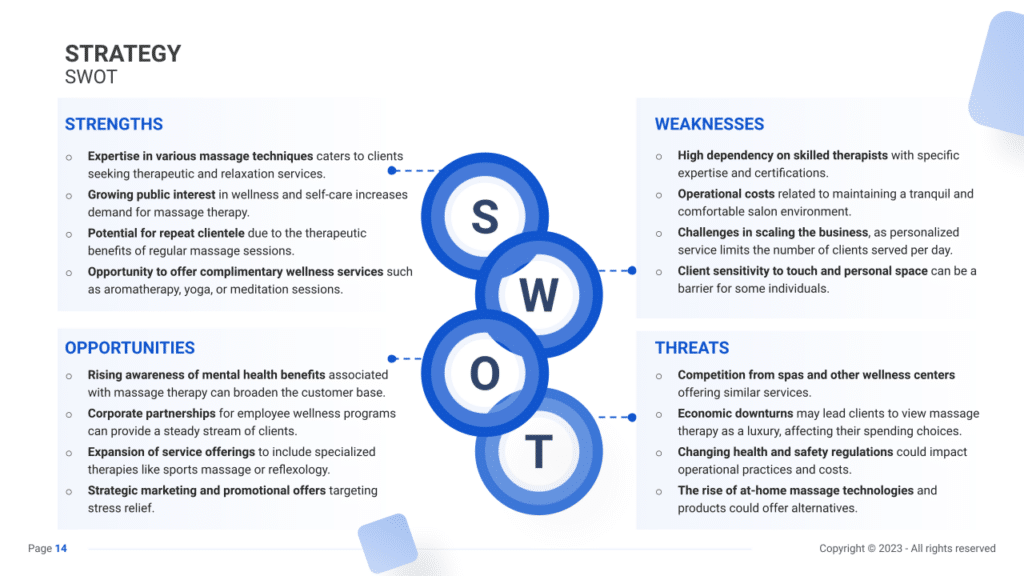
Marketing Plan
Next, develop a marketing strategy that outlines how to attract and retain clients through strategies like targeted online advertising, introductory offers, referral programs, a strong and informative social media presence, and involvement in local health and wellness events. Consider partnerships with local businesses, healthcare providers, or fitness centers to reach a broader audience.
Marketing Channels
Selecting appropriate marketing channels is crucial to communicating your brand and services to potential clients.
Digital Marketing
- Social Media Presence: Utilize platforms like Instagram, Facebook, or YouTube to share wellness tips, client testimonials, and behind-the-scenes glimpses of your practice. Engage with your audience by responding to comments and messages promptly.
- Email Marketing: Build an email list by offering wellness newsletters, exclusive promotions, and self-care tips. Segment your emails based on client interests for targeted communication.
- Website and SEO: Develop an informative website showcasing your services, therapist profiles, testimonials, and online booking. Optimize it for local SEO to attract clients seeking massage therapy in your area.
Local Advertising
Connecting with your local community can be highly effective:
- Flyers and Local Print: Design visually appealing flyers and brochures to distribute in health food stores, gyms, or wellness centers. Advertise in local health publications or community newsletters.
- Community Engagement: Participate in local health fairs, wellness events, or charity initiatives. Offer free chair massages or workshops to showcase your expertise.
- Collaborations: Partner with gyms, wellness centers, or chiropractors for cross-promotions or referrals. Join local business alliances to expand your reach.
- Health and Wellness Collaborations: Network with health practitioners like chiropractors, physiotherapists, or yoga studios for joint events or client referrals.
- Corporate Wellness Programs: Approach local businesses to offer workplace massage sessions as part of their employee wellness initiatives.
Promotional Activities
Attract and engage potential clients through compelling offers and loyalty programs.
- Introductory Offers: Launch introductory packages or discounted sessions for first-time clients to encourage trial.
- Loyalty Programs: Implement loyalty cards rewarding clients after a certain number of sessions with a complimentary massage session or an add-on service.
- Referral Programs: Encourage existing clients to refer new clients by offering incentives such as discounted sessions or wellness products.
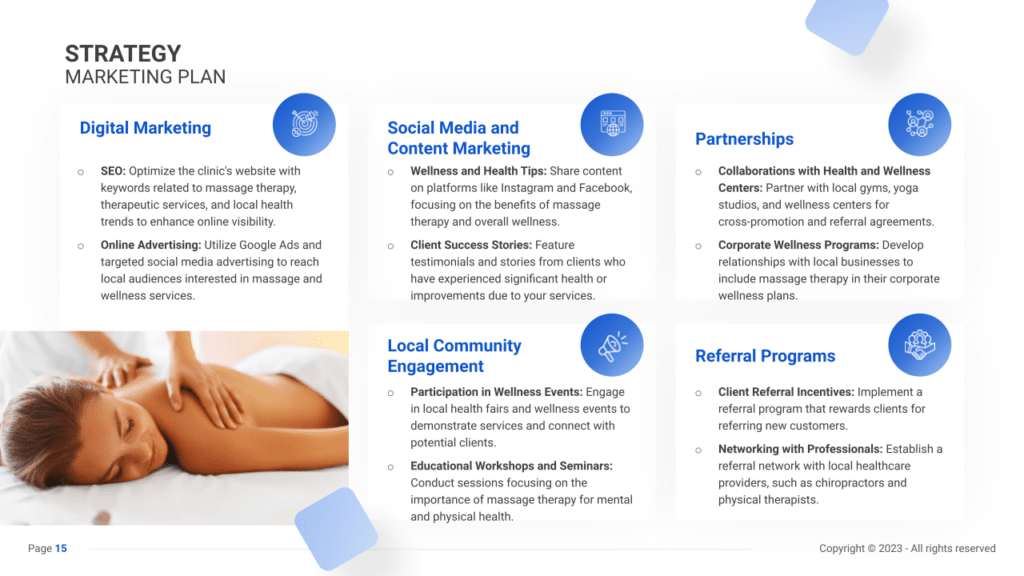
Sales Channels
Sales channels are crucial for maximizing revenue and ensuring customer satisfaction. Implement effective sales strategies to enhance revenue and client satisfaction.
Upselling and Service Packages
Maximize revenue with each customer visit:
- Additional Services: Offer upgrades like aromatherapy, hot stone massages, or extended sessions for a personalized experience.
- Retail Products: Sell wellness products like essential oils, massage tools, or relaxation aids to complement your services.
- Package Deals: Bundle services into packages like ‘Couples Relaxation Sessions’ or ‘Wellness Membership Packages’ at discounted rates.
Online Booking and Sales
Leverage technology to streamline sales:
- User-Friendly Booking Systems: Simplify the booking process with an intuitive online booking system integrated into your website and social media platforms. Offer incentives for online bookings, such as complimentary add-ons or discounts.
- E-commerce Integration: Sell wellness products or gift cards online. Create limited-edition wellness kits or exclusive product bundles for online purchase.
- Virtual Consultations: Offer online consultations for personalized massage therapy advice, leading to tailored service bookings and product recommendations.
Membership and Loyalty Programs
Encourage repeat clients:
- Membership Options: Offer subscription-based membership plans that include regular sessions at discounted rates or exclusive access to premium services.
- Loyalty Rewards: Develop a digital loyalty program where clients earn points for each session attended or for referrals, redeemable for discounted sessions or exclusive wellness workshops.
Strategy Timeline
Finally, create a detailed timeline that outlines critical milestones for the massage therapy clinic’s launch, marketing initiatives, client base development, and potential expansion goals. This should include short-term actions for the initial setup and launch phase, as well as long-term strategies for growth and sustainability, ensuring the business progresses with clear direction and purpose.

Management
The Management section focuses on the massage therapy business’s management and their direct roles in daily operations and strategic direction. This part is crucial for understanding who is responsible for making key decisions and driving the massage therapy towards its financial and operational goals.
For your massage therapy business plan, list the core team members, their specific responsibilities, and how their expertise supports the business.


Financial Plan
The Financial Plan section is a comprehensive analysis of your financial projections for revenue, expenses, and profitability. It lays out your message therapy business’s approach to securing funding, managing cash flow, and achieving breakeven.
This section typically includes detailed forecasts for the first 5 years of operation, highlighting expected revenue, operating costs and capital expenditures.
For your massage therapy business plan, provide a snapshot of your financial statement (profit and loss, balance sheet, cash flow statement), as well as your key assumptions (e.g. number of customers and prices, expenses, etc.).
Make sure to cover here
_ Profit and Loss
_ Cash Flow Statement
_ Balance Sheet
_ Use of Funds
